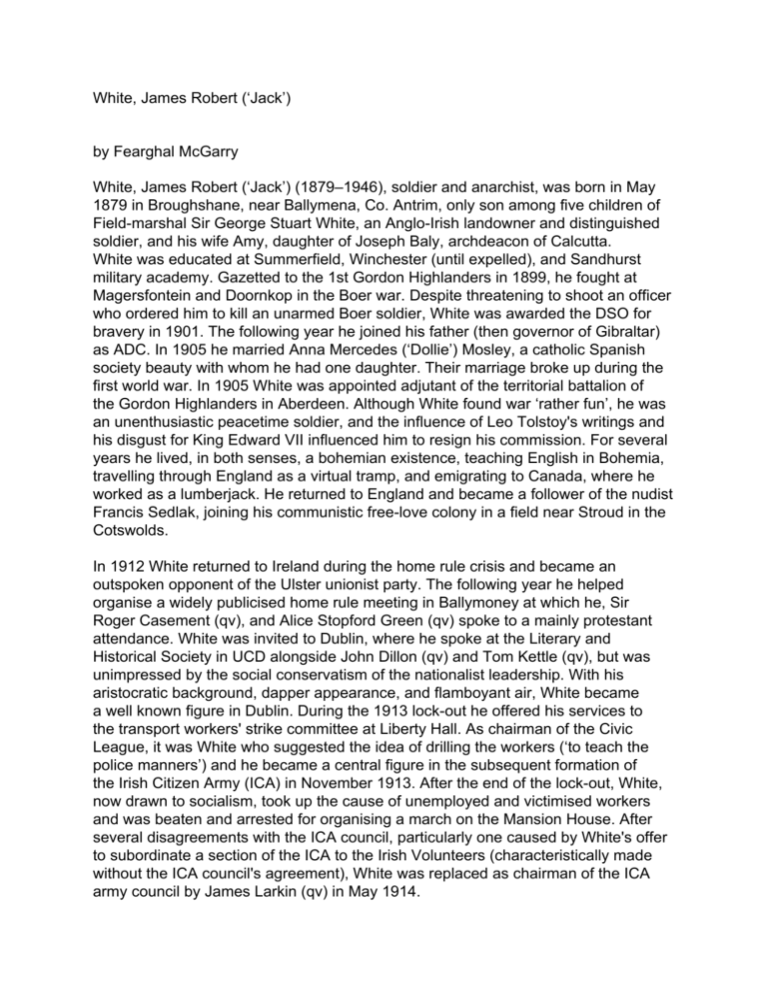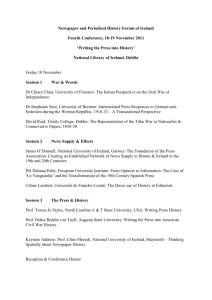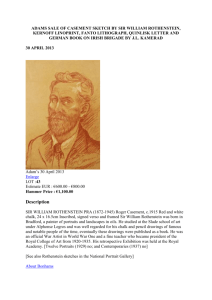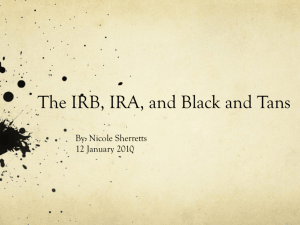
White, James Robert (‘Jack’)
by Fearghal McGarry
White, James Robert (‘Jack’) (1879–1946), soldier and anarchist, was born in May
1879 in Broughshane, near Ballymena, Co. Antrim, only son among five children of
Field-marshal Sir George Stuart White, an Anglo-Irish landowner and distinguished
soldier, and his wife Amy, daughter of Joseph Baly, archdeacon of Calcutta.
White was educated at Summerfield, Winchester (until expelled), and Sandhurst
military academy. Gazetted to the 1st Gordon Highlanders in 1899, he fought at
Magersfontein and Doornkop in the Boer war. Despite threatening to shoot an officer
who ordered him to kill an unarmed Boer soldier, White was awarded the DSO for
bravery in 1901. The following year he joined his father (then governor of Gibraltar)
as ADC. In 1905 he married Anna Mercedes (‘Dollie’) Mosley, a catholic Spanish
society beauty with whom he had one daughter. Their marriage broke up during the
first world war. In 1905 White was appointed adjutant of the territorial battalion of
the Gordon Highlanders in Aberdeen. Although White found war ‘rather fun’, he was
an unenthusiastic peacetime soldier, and the influence of Leo Tolstoy's writings and
his disgust for King Edward VII influenced him to resign his commission. For several
years he lived, in both senses, a bohemian existence, teaching English in Bohemia,
travelling through England as a virtual tramp, and emigrating to Canada, where he
worked as a lumberjack. He returned to England and became a follower of the nudist
Francis Sedlak, joining his communistic free-love colony in a field near Stroud in the
Cotswolds.
In 1912 White returned to Ireland during the home rule crisis and became an
outspoken opponent of the Ulster unionist party. The following year he helped
organise a widely publicised home rule meeting in Ballymoney at which he, Sir
Roger Casement (qv), and Alice Stopford Green (qv) spoke to a mainly protestant
attendance. White was invited to Dublin, where he spoke at the Literary and
Historical Society in UCD alongside John Dillon (qv) and Tom Kettle (qv), but was
unimpressed by the social conservatism of the nationalist leadership. With his
aristocratic background, dapper appearance, and flamboyant air, White became
a well known figure in Dublin. During the 1913 lock-out he offered his services to
the transport workers' strike committee at Liberty Hall. As chairman of the Civic
League, it was White who suggested the idea of drilling the workers (‘to teach the
police manners’) and he became a central figure in the subsequent formation of
the Irish Citizen Army (ICA) in November 1913. After the end of the lock-out, White,
now drawn to socialism, took up the cause of unemployed and victimised workers
and was beaten and arrested for organising a march on the Mansion House. After
several disagreements with the ICA council, particularly one caused by White's offer
to subordinate a section of the ICA to the Irish Volunteers (characteristically made
without the ICA council's agreement), White was replaced as chairman of the ICA
army council by James Larkin (qv) in May 1914.
He returned to Ulster, where he organised the Irish Volunteers in Derry city
and Omagh, Co. Tyrone, but was dismissed from both commands after political
disagreements. White felt the outbreak of the Great War offered an opportunity
to unite protestants and catholics, but the local Volunteers, whom he regarded
as sectarian, viewed him as a unionist sympathiser. He left for France, where he
spent two years with an Australian ambulance unit but was mistrusted due to his
previous association with Casement. Disgusted by the war, he returned to Britain
shortly after the Easter rising and was imprisoned for three months for organising
a Welsh miners' strike to protest against the execution of James Connolly (qv).
After his release he was served with an exclusion order from Ireland by Henry Duke
(qv), chief secretary for Ireland. He remained in England, where he became friendly
with the literary circle of D. H. Lawrence (who portrayed White as ‘Jim Bricknell’ in
his novel Aaron's rod). In 1923, after the civil war, a Donegal republican workers'
council invited White to stand for the general election. Although initially enthusiastic,
White withdrew, denouncing republican physical force as ‘morally and politically
unsound’ and advocating Christian communism. He joined James Larkin's Irish
Workers’ League (founded in 1923) and, along with Roddy Connolly (qv), was a
founder member of the communist Workers' Party of Ireland, established in 1926. In
1930 he published an autobiography, aptly titled Misfit. He was jailed the following
year in Northern Ireland for his involvement in the Revolutionary Workers' Groups'
unemployment protests. Served with a exclusion order from Northern Ireland by Sir
Dawson Bates (qv), minister for home affairs, in 1931 White agreed not to participate
in northern politics in order to continue seeing the child of his estranged wife.
White supported the short-lived Republican Congress, established in 1934, and
organised a Dublin branch composed of ex-servicemen. In the mid-1930s he
became a committed anti-fascist, writing the anti-fascist tract ‘Where Casement
would have stood today’ and travelling to republican Spain as a Red Cross worker
when the Spanish civil war broke out in 1936. After reportedly falling out with the
communist-led International Brigades, White converted to anarchism on witnessing
anarchist collectivisation and militias in action. He supported the anarchist CNT
trade union and, it is thought, trained militias in Spain. He subsequently published
a pamphlet, The meaning of anarchism, which argued that workers must free
themselves through revolution by direct action and the substitution of ‘free humanity’
for the state. He left Spain for London where, despite disapproving of the CNT's
cooperation with the republican government, he worked alongside Emma Goldman
to support the Spanish anarchists through publicity and, reportedly, gun-running.
In 1937 White married Noreen Shanahan, a catholic from Dalkey, Co. Dublin, with
whom he had three sons. He died in February 1946 and is buried at Broughshane
First Presbyterian Church. White's eccentricity, idiosyncratic political outlook (a
mixture of Christianity, Leninism, and mysticism) and unconventional enthusiasms
(including psychoanalysis, free love, and anti-clericalism) rendered him a permanent
outsider among even Irish radicals. A naive and romantic figure, White believed his
life was characterised by ‘involuntary yet outrageous, even indecent, revolt against
discipline, established custom, and mechanical habit’ (Misfit, 15).
---------------------------------------------------------------------------------------------------------------J. R. White, Misfit: an autobiography (1930); PRONI, Home Affairs papers, 32/1/608;
Ir. Times, 15 Sept. 1978; Uinseann MacEoin, The IRA in the twilight years (1997);
Fearghal McGarry, Irish politics and the Spanish civil war (1999); Andrew Boyd,
Jack White (2001); James Meenan, Centenary history of the Literary and Historical
Society. . .1855–1955 (2005 ed.), 118
Downloaded from http://dib.cambridge.org by IP 192.168.60.239 on Wed Apr 01 09:17:37 BST 2015 Dictionary of Irish
Biography Online © 2015 Cambridge University Press and Royal Irish Academy.All rights reserved. Not for commercial use or
unauthorized distribution.










